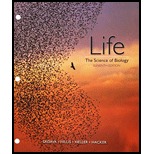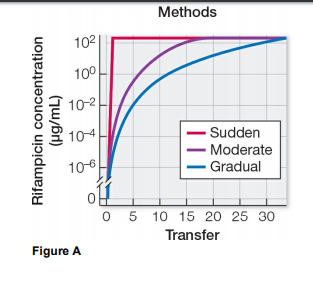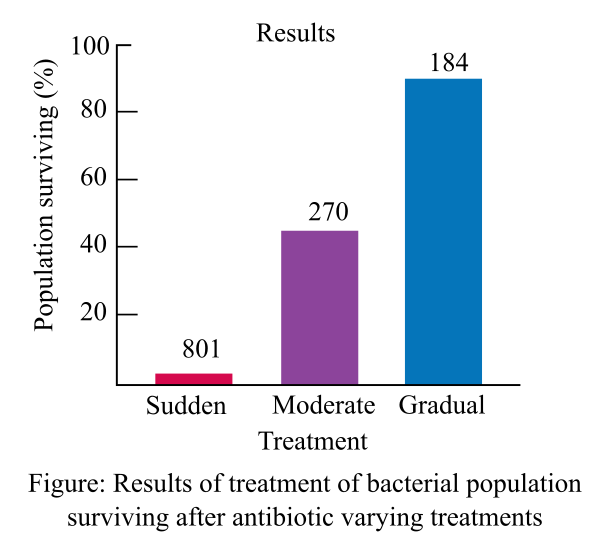
Concept explainers
To analyze:
The results of the investigation showing the relationship between gradual and sudden environmental changes on the extinction, evolution, and adaptation of the populations.
Given:
Overuse of drugs has been associated with the significant increase in drug-resistance. In the given experiment, the researchers use a serial transfer for propagating 1,255 population of Escherichia coli in gradually increasing antibiotic (rifampicin) concentration environment.

Figure A shows the increasing rifampicin concentrations which are increased suddenly, gradually and moderately.

In the figure B the results of the experiments depicting the percentage of population surviving the antibiotic conditions are shown.
Introduction:
Extinction of the organisms is by the fact of sudden changes which occur in ecosystem. Sudden changes do not allow the organism to adapt and acclimatize to the environmental conditions. Gradual changes allow the organism to get accustomed to the changes and allow it to adapt accordingly.
Explanation of Solution
The experiment involved the exposure of antibiotic to the bacteria, by two ways one gradual other sudden. Survival population after treatment with different antibiotic concentrations at different rates differed greatly.
It is very much clear from survival population numbers in the graph that a sudden increase leads to the death because of such sudden increase in antibiotic concentration.
In the case of gradual increase the bacteria survived eventually end up becoming antibiotic resistant because of the fact that the gradual increase allowed the bacteria to save and protect itself by acquiring plasmids, point mutations, and genetic recombination.
The less time in sudden increase in antibiotics made the bacterium incapable of genetic exchange and hence the bacterial population decreased in numbers considerably.
The above experiment can explain the adaptation in case of multidrug resistant (MDR) and extensively drug resistant (XDR) species of Mycobacterium tuberculosis as well as sudden extinction of dinosaurs.
Therefore, it can be concluded that the extinction and loss of organisms is due to sudden change in environmental factors whereas acclimatization is the result of gradual changes in the environmental conditions.
Want to see more full solutions like this?
Chapter 1 Solutions
LIFE: THE SCIENCE OF BIOLOGY
- 22. Which of the following mutant proteins is expected to have a dominant negative effect when over- expressed in normal cells? a. mutant PI3-kinase that lacks the SH2 domain but retains the kinase function b. mutant Grb2 protein that cannot bind to RTK c. mutant RTK that lacks the extracellular domain d. mutant PDK that has the PH domain but lost the kinase function e. all of the abovearrow_forwardWhat is the label ?arrow_forwardCan you described the image? Can you explain the question as well their answer and how to get to an answer to an problem like this?arrow_forward
- Describe the principle of homeostasis.arrow_forwardExplain how the hormones of the glands listed below travel around the body to target organs and tissues : Pituitary gland Hypothalamus Thyroid Parathyroid Adrenal Pineal Pancreas(islets of langerhans) Gonads (testes and ovaries) Placentaarrow_forwardWhat are the functions of the hormones produced in the glands listed below: Pituitary gland Hypothalamus Thyroid Parathyroid Adrenal Pineal Pancreas(islets of langerhans) Gonads (testes and ovaries) Placentaarrow_forward
- Describe the hormones produced in the glands listed below: Pituitary gland Hypothalamus Thyroid Parathyroid Adrenal Pineal Pancreas(islets of langerhans) Gonads (testes and ovaries) Placentaarrow_forwardPlease help me calculate drug dosage from the following information: Patient weight: 35 pounds, so 15.9 kilograms (got this by dividing 35 pounds by 2.2 kilograms) Drug dose: 0.05mg/kg Drug concentration: 2mg/mLarrow_forwardA 25-year-old woman presents to the emergency department with a 2-day history of fever, chills, severe headache, and confusion. She recently returned from a trip to sub-Saharan Africa, where she did not take malaria prophylaxis. On examination, she is febrile (39.8°C/103.6°F) and hypotensive. Laboratory studies reveal hemoglobin of 8.0 g/dL, platelet count of 50,000/μL, and evidence of hemoglobinuria. A peripheral blood smear shows ring forms and banana-shaped gametocytes. Which of the following Plasmodium species is most likely responsible for her severe symptoms? A. Plasmodium vivax B. Plasmodium ovale C. Plasmodium malariae D. Plasmodium falciparumarrow_forward
 Biology (MindTap Course List)BiologyISBN:9781337392938Author:Eldra Solomon, Charles Martin, Diana W. Martin, Linda R. BergPublisher:Cengage Learning
Biology (MindTap Course List)BiologyISBN:9781337392938Author:Eldra Solomon, Charles Martin, Diana W. Martin, Linda R. BergPublisher:Cengage Learning Concepts of BiologyBiologyISBN:9781938168116Author:Samantha Fowler, Rebecca Roush, James WisePublisher:OpenStax College
Concepts of BiologyBiologyISBN:9781938168116Author:Samantha Fowler, Rebecca Roush, James WisePublisher:OpenStax College Biology: The Dynamic Science (MindTap Course List)BiologyISBN:9781305389892Author:Peter J. Russell, Paul E. Hertz, Beverly McMillanPublisher:Cengage Learning
Biology: The Dynamic Science (MindTap Course List)BiologyISBN:9781305389892Author:Peter J. Russell, Paul E. Hertz, Beverly McMillanPublisher:Cengage Learning
 Biology 2eBiologyISBN:9781947172517Author:Matthew Douglas, Jung Choi, Mary Ann ClarkPublisher:OpenStax
Biology 2eBiologyISBN:9781947172517Author:Matthew Douglas, Jung Choi, Mary Ann ClarkPublisher:OpenStax Human Heredity: Principles and Issues (MindTap Co...BiologyISBN:9781305251052Author:Michael CummingsPublisher:Cengage Learning
Human Heredity: Principles and Issues (MindTap Co...BiologyISBN:9781305251052Author:Michael CummingsPublisher:Cengage Learning





